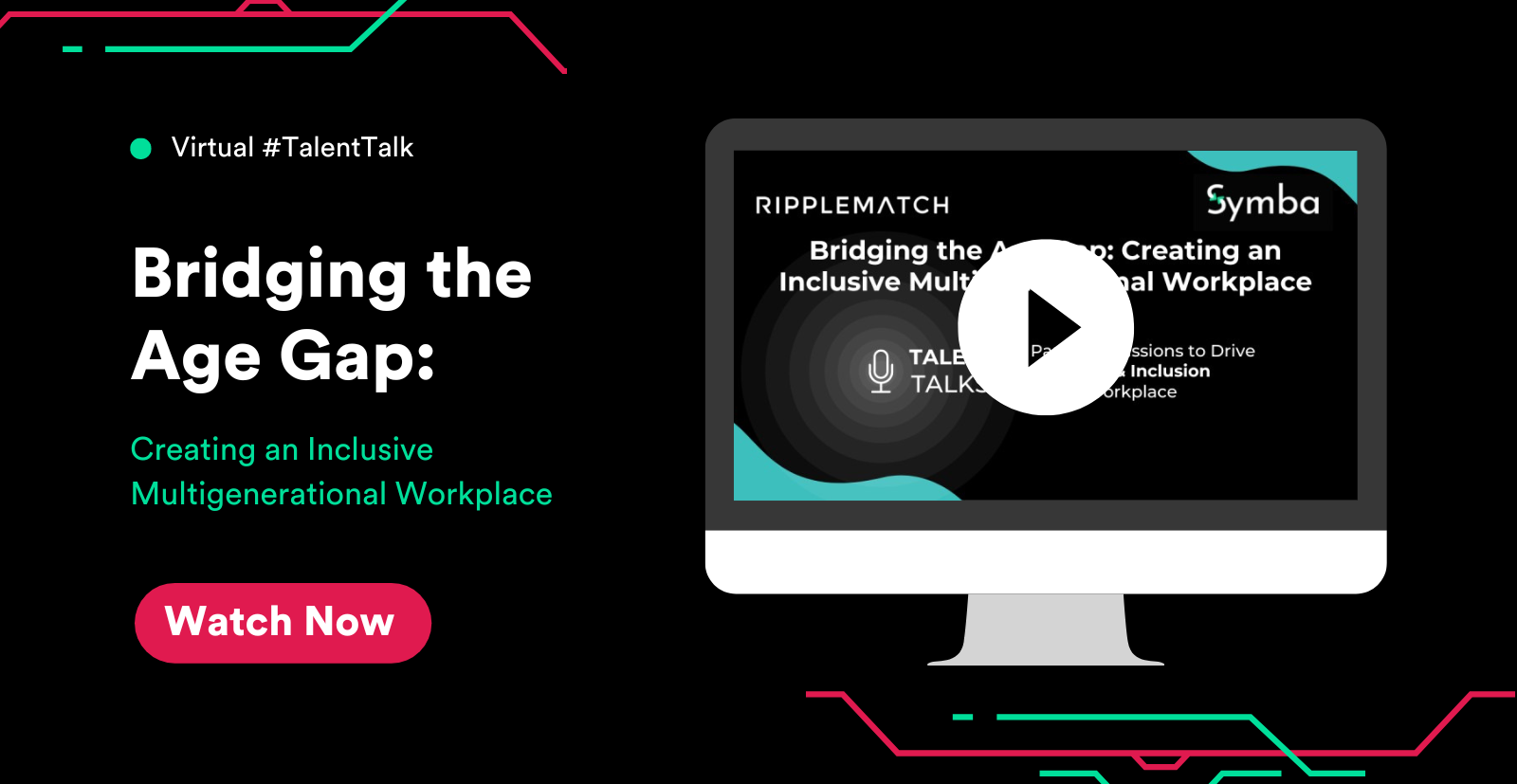Did you know that in the next decade, Gen Z will make up over 30% of the global workforce? At the same time, 20% of baby boomers will retire. There are currently 5 generations contributing to the workforce, managing and mentoring each other. In order to have a harmonious work environment, it is essential that talent leaders make a conscious effort to create a workplace that is inclusive of workers of all ages.
Symba and RippleMatch co-hosted a panel featuring Vanesa Dougherty, Talent and Performance Management Lead at Capital One, and Elizabeth Diley, Campus Talent Acquisition Leader at General Mills, who shared insights on how to tackle the challenges and catalyze opportunities with a multigenerational workforce.
If you missed the event, worry not! Here are 5 key takeaways:
1) Leave assumptions at the door.
No two employees are the same, regardless of belonging to the same generation. You need to find out what each employee needs, which has become increasingly challenging since the COVID-19 pandemic caused a shift to virtual/hybrid workplace structures.
Holding assumptions about the different generations of the workforce can make it extremely challenging to create a cohesive working environment, according to Dougherty. The best way to be an effective leader of a multigenerational workplace is to acknowledge and accept that you do not know everything. One potential way to gather information, instead of assuming it, is through the use of surveys. You can quickly and directly find out what your employees need.
2) Evaluate your recruitment process to ensure it is attractive to talent of all ages.
Not every employee entering the workplace is a ‘fresh out of college, 18-22 year old Gen Z.’ Some are older and looking to relaunch their career, some are transitioning from the military, some are mothers returning to the workforce, and some may have gone back to school for further education. If your recruitment process requires qualifications like a minimum GPA or university experience, you could be turning away valuable talent. Take time to evaluate your current recruitment process to ensure it is inclusive to talent of all ages, not just youth.
- What kinds of questions are you asking in interviews?
- Do the answers you're looking for discriminate on the basis of age?
- Are you open to non-traditional answers?
- Do you require certain markers candidates may not have? (i.e. GPA)
Educate yourself on generational differences to maintain age-inclusive recruitment strategies.
3) Provide career advancement opportunities for each employee’s unique goals.
Continue to offer career growth and development, especially to older generations. Every employee is at a different level of their career journey and they all have unique goals, so make sure to ask and then invest in professional development opportunities that your employees desire. You can also leverage this advancement for your own talent pipeline; align your professional development operations with the skills your organization wants to increase. Check in with your employees and identify those development gaps, and use that information to create the right opportunities for them.
4) Pair up older generation mentors with younger generation mentees.
Many Gen-Zers are entering professional positions for the first time and they might need support from your team. Help them grow by matching early talent with older full-time employees. Mentor/mentee relationships create the opportunity for older generations to educate, guide, and advocate for younger ones, overall boosting their confidence in the workforce.
Additionally, this symbiotic learning relationship can level up your mentors, especially those in managerial positions. Guiding another employee allows these mentors/managers to grow their teaching skills, improve feedback processes, develop new perspectives, and more.
The relationship may not happen naturally, so employers need to take initiative to connect people. Here are a few methods to introduce mentors and mentees:
- Host inspiring roundtables with speakers from different generations.
- Create multigenerational working groups to solve company problems, theoretical or real.
- Schedule coffee chats between new talent and older employees to introduce opportunities for connection.
5) Reframe the narrative from an age ‘gap’ to an age ‘opportunity’.
“Learning comes with bringing in a lot of different backgrounds, no matter where you’re coming from,” said Diley. “Looking at an organization with fresh ideas and a new lens… that only makes us better.”
Generational diversity brings in different perspectives and balances out the workforce. Learn to look at the age differences in your talent as an opportunity to bring in new ways of thinking. You need new minds coming in with ideas and questioning what the current workforce is doing just as much as you need older, experienced employees to share their perspectives. Encourage diversity of thought at your company and you’ll invite new approaches to solving problems and better serve a wider audience.
Did you find these takeaways helpful? Watch the full #TalentTalk session here.





